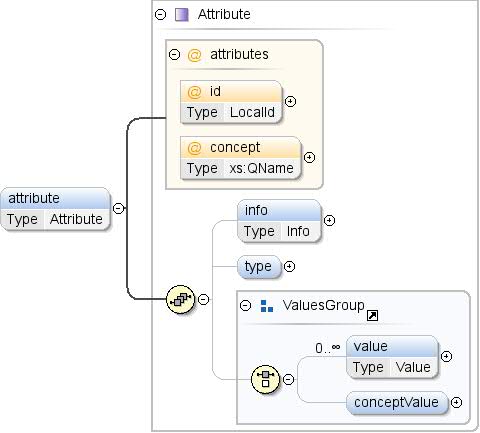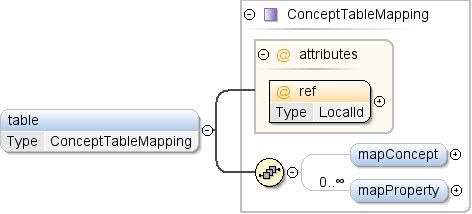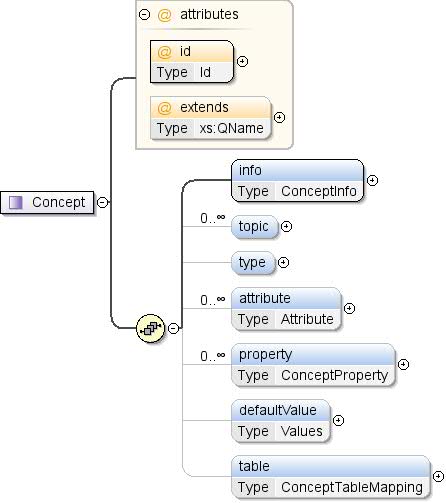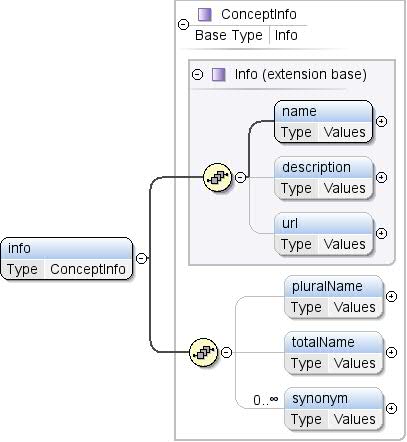组件:概念
元素:概念 / 信息
元素:概念 / 主题
| 命名空间 |
http://schemas.google.com/dspl/2010 |
| 注释 |
与概念相关的主题。 |
| 图示 |
 |
| 属性 |
| content: |
复杂 |
| 最少发生次数: |
0 |
| maxOccurs: |
无界限 |
|
| 属性 |
| QName |
类型 |
固定 |
默认 |
使用 |
注解 |
| 参考 |
xs:QName |
|
|
可选 |
此概念的主题的唯一标识符
资源。引用的主题可以在同一
或外部(即存储在另一个数据集中)。对
外部主题的形式必须为
“prefix:other_topic_id”,其中“prefix”是
外部数据集命名空间的前缀(请参阅 XML)
命名空间)。 |
|
| 来源 |
<xs:element name="topic" minOccurs="0" maxOccurs="unbounded">
<xs:annotation>
<xs:documentation>A topic the concept is associated with.</xs:documentation>
</xs:annotation>
<xs:complexType>
<xs:attribute name="ref" type="xs:QName">
<xs:annotation>
<xs:documentation>The unique identifier of the topic this concept is
associated with.
The referenced topic may be defined in the same
dataset or externally, i.e., in another dataset. A
reference to an external topic must be of the form
"prefix:other_topic_id", where "prefix" is the prefix
used for the namespace of the external dataset (see
XML namespaces).</xs:documentation>
</xs:annotation>
</xs:attribute>
</xs:complexType>
</xs:element>
|
元素:概念 / 类型
| 命名空间 |
http://schemas.google.com/dspl/2010 |
| 注释 |
概念的数据类型。概念必须提供类型
声明或扩展其他概念。在使用
扩展概念时,也可以提供类型声明。该
扩展概念类型的限制必须比
概念来扩展它。“比限制更宽松”(LRT) 是
部分顺序定义如下:字符串 LRT 浮点、LRT 整数
字符串 LRT 日期字符串 LRT 布尔值 |
| 图示 |
 |
| 属性 |
|
| 属性 |
|
| 来源 |
<xs:element name="type" minOccurs="0">
<xs:annotation>
<xs:documentation>The data type of the concept. A concept must provide a type declaration or extend
another concept. In the case where it's extending a concept, it may also
provide a type declaration. The type of the extended concept must be less restrictive
than the type of the concept extending it.
"Less restrictive than" (LRT) is a partial order defined as follows:
string LRT float
float LRT integer
string LRT date
string LRT boolean</xs:documentation>
</xs:annotation>
<xs:complexType>
<xs:attribute name="ref" type="DataType" use="required"/>
</xs:complexType>
</xs:element>
|
元素:概念 / 属性
| 命名空间 |
http://schemas.google.com/dspl/2010 |
| 注释 |
概念的属性。属性代表
概念的相关信息(例如,GDP 是一个百分比)。 |
| 图示 |
 |
| 类型 |
属性 |
| 属性 |
| content: |
复杂 |
| 最少发生次数: |
0 |
| maxOccurs: |
无界限 |
|
| 型号 |
info{0,1}、type{0,1}、(value*
|conceptValue{0,1}) |
| 儿童 |
conceptValue、info、type、
值 |
| 实例 |
<attribute concept="" id="">
<info>{0,1}</info>
<type format="" ref="">{0,1}</type>
</attribute>
|
| 属性 |
| QName |
类型 |
固定 |
默认 |
使用 |
注解 |
| 概念 |
xs:QName |
|
|
可选 |
对与值对应的概念的引用
属性。如果属性指定类型,则该类型
必须与所引用概念的类型相匹配。对
外部概念必须采用以下格式
“prefix:other_concept_id”,其中“前缀”为
用于外部数据集的命名空间的前缀(请参阅 XML)
命名空间)。 |
| id |
LocalId |
|
|
可选 |
概念属性的 ID。此标识符必须是
在概念内是唯一的(在所有属性和属性之间)。通过
如果指定了 concept 属性,则可以省略 id。在该部分中,
会隐式创建 ID,其值为
引用的概念例如 <attribute
concept="unit:currency"/>等同于
<attribute id="currency"
concept="unit:currency"/> |
|
| 来源 |
<xs:element name="attribute" type="Attribute" minOccurs="0" maxOccurs="unbounded">
<xs:annotation>
<xs:documentation>An attribute of the concept. Attributes represent additional
information about the concept (e.g., GDP is a percentage).</xs:documentation>
</xs:annotation>
</xs:element>
|
元素:概念 / 属性
| 命名空间 |
http://schemas.google.com/dspl/2010 |
| 注释 |
概念的属性。属性代表
概念实例的相关信息(例如,
"城市"可能包含“country”属性)。 |
| 图示 |
 |
| 类型 |
ConceptProperty |
| 属性 |
| content: |
复杂 |
| 最少发生次数: |
0 |
| maxOccurs: |
无界限 |
|
| 型号 |
info{0,1}、type{0,1} |
| 儿童 |
info、type |
| 实例 |
<property concept="" id="" isMapping="false" isParent="false">
<info>{0,1}</info>
<type ref="">{0,1}</type>
</property>
|
| 属性 |
| QName |
类型 |
固定 |
默认 |
使用 |
注解 |
| 概念 |
xs:QName |
|
|
可选 |
对与值对应的概念的引用
属性。如果属性指定了 类型,则该类型
必须与所引用概念的类型相匹配。对
外部概念必须采用以下格式
“prefix:other_concept_id”,其中“前缀”为
用于外部数据集的命名空间的前缀(请参阅 XML)
命名空间)。 |
| id |
LocalId |
|
|
可选 |
概念属性的 ID。此标识符必须是
在概念内是唯一的(在所有属性和属性之间)。通过
如果指定了 concept 属性,则可以省略 id。在该部分中,
在这种情况下,系统将隐式创建一个 ID,其值为
引用的概念例如 <property
concept="geo:country"/>等同于 <property
id="country"
concept="geo:country"/> |
| isMapping |
xs:boolean |
|
false |
可选 |
如果为 true,则此属性必须引用概念,并且
此属性表示
概念和引用的概念。引用的
最多仅有一个实例引用此概念,
概念。 |
| isParent |
xs:boolean |
|
false |
可选 |
如果为 true,则此属性必须引用概念,并且
这一属性表示二者之间的层级关系,
概念和所引用的概念(例如
国家/地区)。 |
|
| 来源 |
<xs:element name="property" type="ConceptProperty" minOccurs="0" maxOccurs="unbounded">
<xs:annotation>
<xs:documentation>A property of the concept. Properties represent additional
information about instances of the concept (e.g., a concept
"city" may have a property "country").</xs:documentation>
</xs:annotation>
</xs:element>
|
元素:Concept / defaultValue
| 命名空间 |
http://schemas.google.com/dspl/2010 |
| 注释 |
概念的默认值,将由应用使用
选择某个可能的
概念。 |
| 图示 |
 |
| 类型 |
值 |
| 属性 |
|
| 型号 |
value* |conceptValue{0,1} |
| 儿童 |
conceptValue、value |
| 实例 |
<defaultValue>
<value lang="">{0,unbounded}</value>
<conceptValue concept="">{0,1}</conceptValue>
</defaultValue>
|
| 来源 |
<xs:element name="defaultValue" type="Values" minOccurs="0">
<xs:annotation>
<xs:documentation>A default value for the concept, to be used by
applications when they need to pick one of the possible
values of the concept.</xs:documentation>
</xs:annotation>
</xs:element>
|
元素:概念 / 表格
| 命名空间 |
http://schemas.google.com/dspl/2010 |
| 注释 |
对包含所有可能值的表的引用
概念及其非常量属性。 |
| 图示 |
 |
| 类型 |
ConceptTableMapping |
| 属性 |
|
| 型号 |
mapConcept{0,1} , mapProperty* |
| 儿童 |
mapConcept、mapProperty |
| 实例 |
<table ref="">
<mapConcept toColumn="">{0,1}</mapConcept>
<mapProperty lang="" ref="" toColumn="">{0,unbounded}</mapProperty>
</table>
|
| 属性 |
| QName |
类型 |
固定 |
默认 |
使用 |
注解 |
| 参考 |
LocalId |
|
|
必填 |
包含相应指标数据的表的 ID
概念。 |
|
| 来源 |
<xs:element name="table" type="ConceptTableMapping" minOccurs="0">
<xs:annotation>
<xs:documentation>A reference to a table that contains all the
possible values for the concept and its non-constant
properties.</xs:documentation>
</xs:annotation>
</xs:element>
|
复杂类型:概念
| 命名空间 |
http://schemas.google.com/dspl/2010 |
| 注释 |
概念是对出现在
数据集(例如,“GDP”或“国家/地区”)。概念可能是
所有可能值的枚举相关联。答
某个数据集中定义的概念可能
数据集。 |
| 图示 |
 |
| 使用方数量 |
|
| 型号 |
info、topic*、type{0,1}、
attribute*、property*、defaultValue{0,1}、table{0,1} |
| 儿童 |
attribute、defaultValue、info、
property、table、topic、
类型 |
| 属性 |
| QName |
类型 |
固定 |
默认 |
使用 |
注解 |
| 扩展 |
xs:QName |
|
|
可选 |
此概念所代表的概念的唯一标识符
扩展。引用的概念可以在同一数据集中定义
或外部(即存储在另一个数据集中)。对外部 API 的引用
概念必须采用如下格式:“prefix:other_concept_id”
其中“prefix”是
外部数据集(请参阅 XML 命名空间)。 |
| id |
ID |
|
|
必填 |
概念的唯一标识符,必须为
在数据集内具有全局唯一性。 |
|
| 来源 |
<xs:complexType name="Concept">
<xs:annotation>
<xs:documentation>A concept is a definition of a type of data that appears in the
dataset (e.g., "GDP" or "County"). A concept may be associated with
an enumeration of all its possible values or not. A concept defined in
some dataset may be referenced in other datasets.</xs:documentation>
</xs:annotation>
<xs:sequence>
<xs:element name="info" type="ConceptInfo">
<xs:annotation>
<xs:documentation>Textual information, such as the name and description of
the concept.</xs:documentation>
</xs:annotation>
</xs:element>
<xs:element name="topic" minOccurs="0" maxOccurs="unbounded">
<xs:annotation>
<xs:documentation>A topic the concept is associated with.</xs:documentation>
</xs:annotation>
<xs:complexType>
<xs:attribute name="ref" type="xs:QName">
<xs:annotation>
<xs:documentation>The unique identifier of the topic this concept is
associated with.
The referenced topic may be defined in the same
dataset or externally, i.e., in another dataset. A
reference to an external topic must be of the form
"prefix:other_topic_id", where "prefix" is the prefix
used for the namespace of the external dataset (see
XML namespaces).</xs:documentation>
</xs:annotation>
</xs:attribute>
</xs:complexType>
</xs:element>
<xs:element name="type" minOccurs="0">
<xs:annotation>
<xs:documentation>The data type of the concept. A concept must provide a type declaration or extend
another concept. In the case where it's extending a concept, it may also
provide a type declaration. The type of the extended concept must be less restrictive
than the type of the concept extending it.
"Less restrictive than" (LRT) is a partial order defined as follows:
string LRT float
float LRT integer
string LRT date
string LRT boolean</xs:documentation>
</xs:annotation>
<xs:complexType>
<xs:attribute name="ref" type="DataType" use="required"/>
</xs:complexType>
</xs:element>
<xs:element name="attribute" type="Attribute" minOccurs="0" maxOccurs="unbounded">
<xs:annotation>
<xs:documentation>An attribute of the concept. Attributes represent additional
information about the concept (e.g., GDP is a percentage).</xs:documentation>
</xs:annotation>
</xs:element>
<xs:element name="property" type="ConceptProperty" minOccurs="0" maxOccurs="unbounded">
<xs:annotation>
<xs:documentation>A property of the concept. Properties represent additional
information about instances of the concept (e.g., a concept
"city" may have a property "country").</xs:documentation>
</xs:annotation>
</xs:element>
<xs:element name="defaultValue" type="Values" minOccurs="0">
<xs:annotation>
<xs:documentation>A default value for the concept, to be used by
applications when they need to pick one of the possible
values of the concept.</xs:documentation>
</xs:annotation>
</xs:element>
<xs:element name="table" type="ConceptTableMapping" minOccurs="0">
<xs:annotation>
<xs:documentation>A reference to a table that contains all the
possible values for the concept and its non-constant
properties.</xs:documentation>
</xs:annotation>
</xs:element>
</xs:sequence>
<xs:attribute name="id" type="Id" use="required">
<xs:annotation>
<xs:documentation>The unique identifier of the concept, which must be globally
unique within the dataset.</xs:documentation>
</xs:annotation>
</xs:attribute>
<xs:attribute name="extends" type="xs:QName" use="optional">
<xs:annotation>
<xs:documentation>The unique identifier of a concept that this
concept extends.
The referenced concept may be defined in the same
dataset or externally, i.e., in another dataset. A
reference to an external concept must be of the form
"prefix:other_concept_id", where "prefix" is the
prefix used for the namespace of the external
dataset (see XML namespaces).</xs:documentation>
</xs:annotation>
</xs:attribute>
</xs:complexType>
|
属性:概念 / 主题 / @ref
| 命名空间 |
没有命名空间 |
| 注释 |
与此概念相关联的主题的唯一标识符
引用的主题可以在同一数据集中定义,或者
即在另一个数据集中。对外部主题的引用
必须采用“prefix:other_topic_id”格式,其中
"前缀"是外部命名空间的命名空间的前缀,
数据集(请参阅 XML 命名空间)。 |
| 类型 |
xs:QName |
| 属性 |
|
| 使用方数量 |
|
| 来源 |
<xs:attribute name="ref" type="xs:QName">
<xs:annotation>
<xs:documentation>The unique identifier of the topic this concept is
associated with.
The referenced topic may be defined in the same
dataset or externally, i.e., in another dataset. A
reference to an external topic must be of the form
"prefix:other_topic_id", where "prefix" is the prefix
used for the namespace of the external dataset (see
XML namespaces).</xs:documentation>
</xs:annotation>
</xs:attribute>
|
属性:概念 / 类型 / @ref
| 命名空间 |
没有命名空间 |
| 类型 |
DataType |
| 属性 |
|
| 分面 |
| 枚举 |
字符串 |
|
| 枚举 |
float |
|
| 枚举 |
integer |
|
| 枚举 |
布尔值 |
|
| 枚举 |
date |
|
| 枚举 |
concept |
|
|
| 使用方数量 |
|
| 来源 |
<xs:attribute name="ref" type="DataType" use="required"/>
|
属性:概念 / @id
| 命名空间 |
没有命名空间 |
| 注释 |
概念的唯一标识符,必须是全局的
在数据集中是唯一的。 |
| 类型 |
ID |
| 属性 |
|
| 分面 |
|
| 使用方数量 |
|
| 来源 |
<xs:attribute name="id" type="Id" use="required">
<xs:annotation>
<xs:documentation>The unique identifier of the concept, which must be globally
unique within the dataset.</xs:documentation>
</xs:annotation>
</xs:attribute>
|
属性:概念 / @extends
| 命名空间 |
没有命名空间 |
| 注释 |
此概念扩展的概念的唯一标识符。
引用的概念可以在同一数据集中定义,也可以在外部进行。
即在另一个数据集中。对外部概念的引用必须是
“prefix:other_concept_id”形式,其中“prefix”为
用于外部数据集的命名空间的前缀(请参阅 XML)
命名空间)。 |
| 类型 |
xs:QName |
| 属性 |
|
| 使用方数量 |
|
| 来源 |
<xs:attribute name="extends" type="xs:QName" use="optional">
<xs:annotation>
<xs:documentation>The unique identifier of a concept that this
concept extends.
The referenced concept may be defined in the same
dataset or externally, i.e., in another dataset. A
reference to an external concept must be of the form
"prefix:other_concept_id", where "prefix" is the
prefix used for the namespace of the external
dataset (see XML namespaces).</xs:documentation>
</xs:annotation>
</xs:attribute>
|
使用
oXygen XML Editor。
如未另行说明,那么本页面中的内容已根据知识共享署名 4.0 许可获得了许可,并且代码示例已根据 Apache 2.0 许可获得了许可。有关详情,请参阅 Google 开发者网站政策。Java 是 Oracle 和/或其关联公司的注册商标。
最后更新时间 (UTC):2024-08-21。
[null,null,["最后更新时间 (UTC):2024-08-21。"],[],[]]








